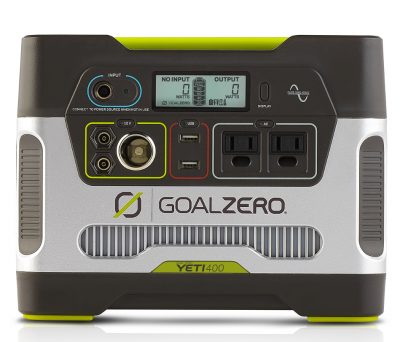 UPDATED 24Oct2019: Are you looking for emergency backup power during a blackout? Solar generators convert the energy of the sun into electrical power for running and charging small items. Solar generators need no fuel, they make no noise and create no exhaust. Every model on the market has four main parts. The battery stores power so it’s available for use even when it’s not sunny outside. The photovoltaic panel converts sunlight into electricity that’s used to recharge the battery. The charge controller ensures that only the right amount of electricity gets fed back into the battery, and the inverter converts the power of a battery into electricity suitable for plug-in household items. I’m a big fan of building your own solar generator from parts, but if you’d rather buy one ready-to-go, you’ll need to start by asking yourself some questions.
UPDATED 24Oct2019: Are you looking for emergency backup power during a blackout? Solar generators convert the energy of the sun into electrical power for running and charging small items. Solar generators need no fuel, they make no noise and create no exhaust. Every model on the market has four main parts. The battery stores power so it’s available for use even when it’s not sunny outside. The photovoltaic panel converts sunlight into electricity that’s used to recharge the battery. The charge controller ensures that only the right amount of electricity gets fed back into the battery, and the inverter converts the power of a battery into electricity suitable for plug-in household items. I’m a big fan of building your own solar generator from parts, but if you’d rather buy one ready-to-go, you’ll need to start by asking yourself some questions.
Solar Generator Question#1: How many watts do you need?
This is the most important question to answer before you make a purchase. This is actually just the first of two different “how big” questions. The first has to do with maximum wattage of power needed. Ready-made solar generators are typically capable of putting out a maximum of 400 to 1250 watts depending on the model. How far will that kind of power output go? A cell phone, for instance, requires less than 10 watts to charge. Hardly any at all. An ordinary electrical kettle, by contrast, uses more than 1200 watts. Most electrical devices have wattage figures printed on them somewhere. Add up the numbers before you start shopping for a solar generator. If there’s no wattage figure on the device or appliance you’re looking at, look for voltage and amperage figures on the manufacturer’s nameplate. Volts x amps = watts. Solar generators don’t generate nearly as much power as a medium or large-size gasoline-powered generator, so you’ll probably need to economize when deciding what you’ll run.
Solar Generator Question#2: How long run time?
This is the second “how big” question. Solar generators harvest light energy from the sun, converting it to electrical energy and storing this power in an on-board battery. The length of time this battery can deliver power is called “run time”. Some solar generators have small on-board batteries and others have larger ones. So, what are your needs? Identify the amount of wattage you expect to consume when the sun isn’t shining, then see how long the various models can provide this amount of power. If all you want to do is keep your laptop and phone charged while having enough power for small lights, a small solar generator will probably check out fine. However, if you’d like more capacity at night and during cloudy weather, add up your wattage numbers and figure out what run time you can expect from various models.
Solar Generator Question#3: How fast does recharging happen?
The internal battery of every solar generator holds power in reserve, but it’s the size and efficiency of the photovoltaic panel that determines how quickly that battery recharges as the generator sits in sunlight. As you shop for a solar generator, be sure to find out how long it takes to fully recharge the battery. The difference between a slow-charging unit and a faster one can be quite extreme.
With answers to the three big questions in your mind, it’s time to begin researching makes and models. Click here to get specific buying information on ready-made solar generators Another option for getting information is solar generator reviews on SolarGenerator guide.